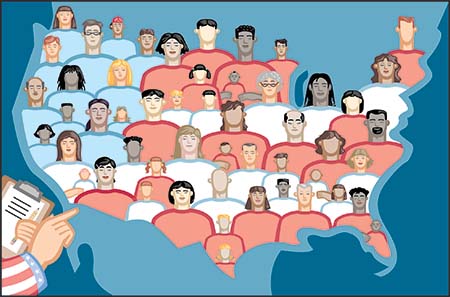 With new population data on record for Alabama, a professor in the College of Arts and Sciences explains how redistricting of electoral boundaries will impact the state moving forward.In 2020, Alabama residents were asked to participate in the Census count, a national data collection that occurs every 10 years to help determine representation in Congress, as well as the share of federal aid each state receives. Alabama had a strong response: The state had a 5.1 percent growth in population since 2010, eclipsed more than 5 million residents and kept its seven congressional seats.
With new population data on record for Alabama, a professor in the College of Arts and Sciences explains how redistricting of electoral boundaries will impact the state moving forward.In 2020, Alabama residents were asked to participate in the Census count, a national data collection that occurs every 10 years to help determine representation in Congress, as well as the share of federal aid each state receives. Alabama had a strong response: The state had a 5.1 percent growth in population since 2010, eclipsed more than 5 million residents and kept its seven congressional seats.
After each federal census, electoral district boundaries must be redrawn to accurately represent population changes and subsequent demographic information — a process known as “redistricting.”
What do Alabamians need to know about how final census data will legislatively impact the state moving forward? Peter Jones, Ph.D., assistant professor in the University of Alabama at Birmingham’s College of Arts and Sciences Department of Political Science and Public Administration, explains what redrawing of districts means for the state now and what Alabamians can expect to see.
Redrawing voting districts
Because voting maps are redrawn, redistricting impacts how our state is legislatively designed moving forward. Redrawing district maps applies to all levels of government, so it is not just congressional or state legislature districts that are redrawn, Jones explains, but extends to areas such as the state board of education and specific cities and counties.
Though states control the redrawing process, federal law includes a few requirements that must be followed to ensure equity in the redistricting process.
“First is the ‘one person, one vote’ requirement, which basically means each district should have the same number of people,” Jones outlined. “This way, one person’s vote for their representative weighs as much in one district as another person’s vote for their representative in another district. Alabama takes this pretty literally, making sure each district is almost identical in size down to the person.”
The second federal condition — following a series of Supreme Court rulings — is that congressional maps must not be redrawn based on race; if that is deemed to be the case, those maps will be struck down.
Understanding Alabama’s new congressional maps
Jones explains that, for most states, the state legislature has primary control over the redistricting process. Since maps are passed based on majority rule, whichever party controls the state legislature tends to hold power in redrawing the maps.
Once new maps are drawn, the state legislature must vote to pass the updated congressional, state senate, state house and state school board districts; Gov. Kay Ivey called a special legislative session to approve the new maps in November 2021.
Drawing new maps is contentious since different populations and communities can be impacted in negative ways, and political parties can intentionally design districts to win future elections more easily — a process most known as “gerrymandering.” Those unhappy with how districts are redrawn argue that those in power drew the maps to protect their majorities in the state legislature but, by doing so, did not make redistricting equitable or representative; on the flip side, those who support the new maps say they are a truer reflection of the makeup of the state.
“Opponents of the new maps often have little recourse in the legislature, so soon after the maps were passed, different groups filed lawsuits alleging that the maps were redrawn with race in mind, which would violate the federal conditions from the Supreme Court rulings,” Jones said.
 Peter Jones, Ph.D.
Peter Jones, Ph.D.
Photography: Steve WoodIn a state like Alabama where one political party controls all three branches of government, there is often controversy with how maps are drawn, and courts must weigh in. However, the aforementioned federal rules in place for remapping are intended to protect the integrity of voting rights.
“The ‘one person, one vote’ rule is incredibly important because it means that, no matter which district you live in, your representative should be as responsive to you as any other representative would be in other districts,” Jones explained.
Jones explains that another common critique of the redistricting process is that geographically larger congressional districts make it more difficult for elected officials to wholly represent the diverse needs of constituents across their district.
“If your district got larger through new maps, it may to be harder for your representative to make decisions that reflect the needs of your specific city or county because they have to balance the needs of other cities/counties too,” Jones said.
Another concern by some is that heavily gerrymandered maps mean incumbents — or those currently holding elected seats — are less likely to lose their positions in elections, which could mean those elected officials can maintain the same policies and legislative agendas in place with little room for change. This can make political races less competitive, too, which could lead to disengagement by citizens in local elections and less oversight in some situations.
Finally, Jones explains that gerrymandered maps make states less politically competitive, which can lead to a “trifecta” where one party controls the legislative, executive and judicial branches. This can often lead to one party’s having their interests represented more than the other, and federal government back-and-forth as well, if run by the opposing party.
“Trifectas have increased over the last few decades, and when the opposing party takes control of a federal government branch (i.e., Congress or the presidency), they are more likely to overrule state policies,” Jones said. “This is the case when either party wins control of federal government branches, which often causes a back-and-forth that can create a lot of confusion, as well as increase public spending when issues are sent to courts for oversight. A timely example of this has been the response to the COVID-19 pandemic, as Republican-led states have passed legislation (i.e., no vaccine mandate) that later conflicts with federal government mandates.”
Unless overruled by courts, redistricted maps are effective immediately and tend to make a quick impact once local and state election cycles get underway.
For residents in Alabama, redistricting is a great reminder that census turnout and accounting for all residents is critical and has long-lasting impacts.
“Filling out the census is a fast and efficient process that really does have real impacts on how a state is represented moving forward,” Jones said. “The more we can educate people on topics like redistricting that have a direct correlation to the census, the more we can continue to engage and encourage residents to pay attention to what’s happening and how they can make a difference.”